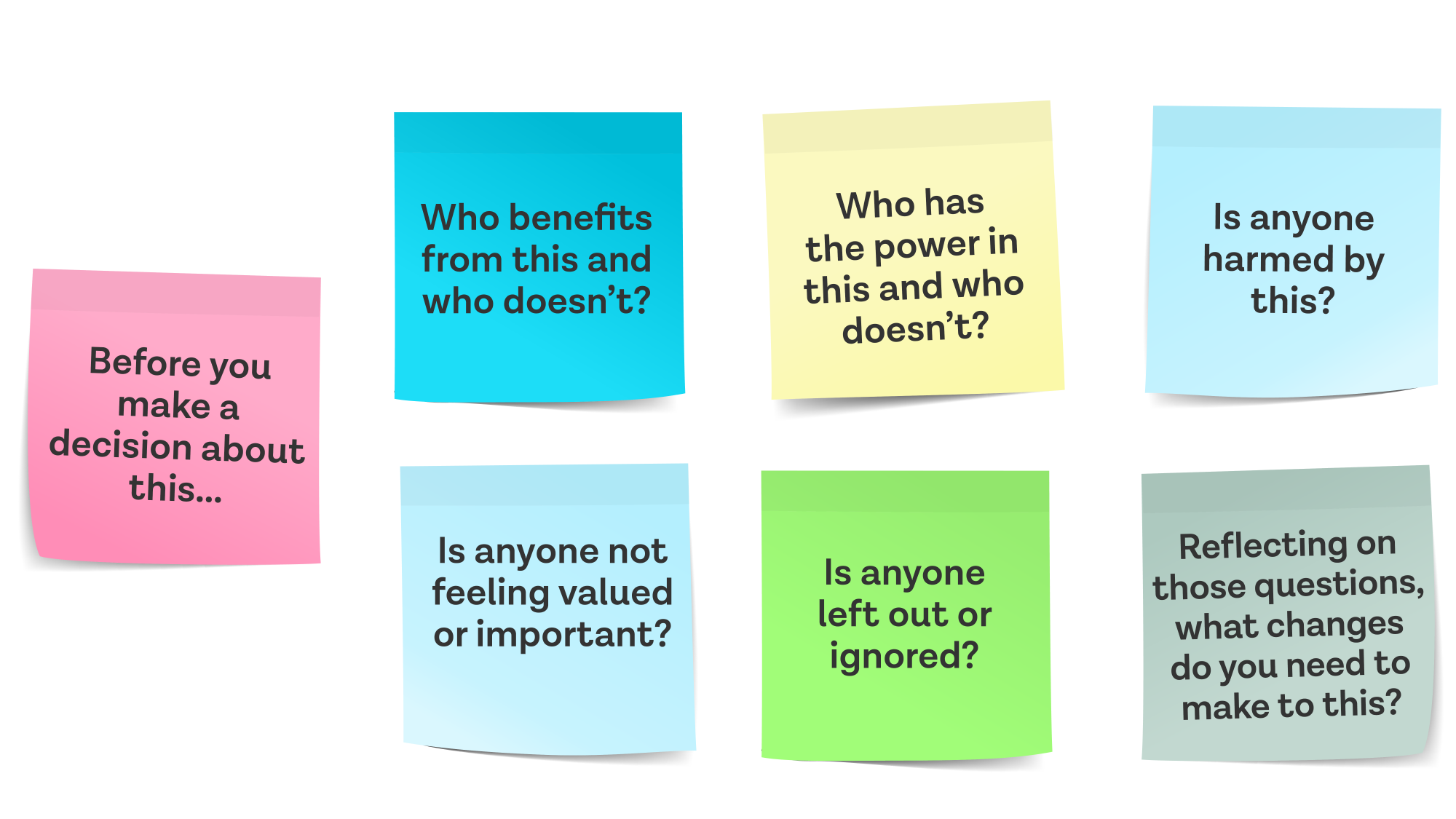Lived experience of the need for intersectional support
Part of the 'Equity Change Project'
Introduction
This section reflects on the importance of intersectional leadership, exploring how intersectionality can be used to challenge unequal power dynamics.
Intersectional leadership
At our expert knowledge exchange (a stage in the change project process), we talked with leaders who were trying to act as change agents. One leader shared these questions which they use to lead inclusively. The questions below have come from social care leader Shabnam Ahmed.

Justice reflective questions (Shabnam Ahmed)
It is important that leaders and managers learn about this.
Change Project participant
Intersectionality challenges unequal power relationships and helps leaders act ethically. The adult social care workforce contains inequity. For example, there are more women than men working in social care, but leadership roles are more likely to be held by men and people with a white ethnic background (Adult Principal Social Workers Network, 2017).
Intersectionality is central to and enhances equality, diversity and inclusion work. An inclusive organisation means an intersectional organisation. Intersectionality reframes equality, diversity and inclusion work as being about equity. The lens of intersectionality offers a way of identifying the situated inequity and overcoming it. Intersectionality means that we have different conversations and different relationships.
What does this look like? Intersectional leaders are aware of their own biases and actively seek out and consider different perspectives to inform their decision-making and collaborate more effectively with others. Intersectional leaders commit to ensuring that all team members:
- are treated equitably,
- feel a sense of belonging and value,
- have the resources and support they need to achieve their full potential.
Leaders need to have intersectional curiosity; this involves asking questions, learning from other people’s situated knowledge, and using their learning as a basis for action. It is important to have feedback from a diverse group of people about your intersectional leadership.
Reflective question
Who has a voice in our organisation?
The tools below aim to build your capability as an intersectional leader and support others to challenge discrimination.
Use this tool to help people reflect on how to challenge discrimination.
Use this tool to build your capability as an intersectional leader.
Use the examples of leaders in the organisations supporting Maggie, Pra and Jack to consider intersectional leadership.
Embedding intersectionality
You need to ensure that actions are very visible, and create a culture where diversity is celebrated.
Change Project participant
Intersectional conversations are required at all levels of an organisation, and leaders are ideally placed to ‘role model’ this. But intersectional leaders then need to go beyond talk to action. This is done through allyship and taking responsibility for using power, removing barriers to others having power and sharing power. For example, in meetings intersectional leaders can ask themselves where the power lies, notice who’s taking a lead and make sure that all voices are heard. Intersectional leaders need to speak up and take action when there is injury. After George Floyd’s murder, social workers in England highlighted that organisations that were silent were, in fact, deafening in their lack of concern for racially minoritised staff (Nayak & Williams, 2022).
Intersectional leaders avoid tokenism (i.e. they need to avoid drawing on a few people to be ‘representative’) and exploitation (i.e. they need to avoid expecting minoritised people to do the work of challenging oppression and overcoming inequity for no reward). It is important to be clear about the principles underpinning action and the outcomes that are expected. Intersectional leaders then hold themselves to account for how far things change. Intersectionality is key to avoiding siloed action that seeks to promote inclusion for people with one characteristic while intersecting elements of identity and intersecting oppression go unacknowledged. Action that happens in silos does not lead to equity.
One way to understand what is happening in your organisation is to create a drawing of the intersecting system of inequity that affects people. We include the intersection exercise here to enable leaders to embed intersectionality in their organisation.
- Name the roads of inequity that intersect.
- Name the vehicles of oppression on the roads.
- Describe the crash that affects people and communities.
- Describe the bio-psycho-social injury. (Nayak, 2022)

The intersection analogy.
Reflective question
How can intersectionality advance existing equality, diversity and inclusion work?
Use the tool below to draw the intersecting roads of inequity in your organisation.
This tool helps you to make inequity in your organisation visible so you can see how to
change it.
Collection of resources supporting 'Putting intersectionality into action - leadership'.